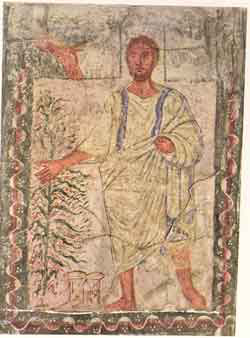Introduction
In the midst of the Joseph stories, Genesis 38 opens with an unrelated scene and immediately introduces a different cast of characters:
Judah - Jacob and Leah’s fourth son, who has just saved Joseph from
certain death by selling him into slavery
Hira the Adullamite – Judah’s new neighbor and friend
Shua - a Canaanite, Judah’s father-in-law
“Bat Shua” – Judah’s wife
Er – Judah’s firstborn
Onan - Judah’s second son
Shelah - Judah's youngest son
Tamar - Er’s bride
Judah has left home and all familial attachment. He marries a Canaanite woman and produces three sons. In a breath, he marries his oldest son, Er, to a woman named Tamar, about whom we know nothing, except that she is immediately widowed through a stroke of mysterious divine judgment against evil Er. In accordance with the law of levirate marriage, her brother-in-law, Onan, is supposed to “join with [his] brother’s wife and do [his] duty by her as a brother-in-law, to provide offspring for [his] brother” (Genesis 38:8). However, Onan refuses to sire a child who will be considered the son of his deceased brother. This man is also felled by God. Judah withholds his youngest son. He tells Tamar that Shelah is too young, but we know that he actually fears that Tamar will “kill” this one also. She is sent home to her father’s house, where she sits in her widows’ weeds waiting in vain for Shelah to grow up and take her.
Years pass. Tamar seizes an opportunity to accomplish what has been denied her: the opportunity to become a mother within her husbands’ family. She hears that her recently widowered father-in-law, Judah, is nearby for a sheep shearing festival. Tamar intuiting his needy state, disguises herself as an available woman and stations herself conspicuously. During the ensuing meeting, Tamar, unrecognized by Judah, negotiates payment for her proposed services. In lieu of the immediate payment of a kid, she demands security: Judah’s seal, cord and staff.
When Judah’s messenger returns to the scene of the encounter to pay the "prostitute", he cannot (of course) find her and Judah considers himself free of obligation. Three months later, he is told that his daughter-in-law, who is supposed to be waiting celibate for his youngest son to take her to wife, is pregnant! Precipitately, Judah condemns her to be burnt at the stake. At the last moment, she sends the security objects to Judah, who recognizes his responsibility and proclaims her innocence.
Twin sons, Perez and Zerah, are born, who perpetuate Judah’s line to David.
The story is replete with puzzles:
1. Why does Judah leave his family in the first place?
2. What is “evil” about Er, that brings God to kill him?
3. Why does Onan not want to provide “seed” for his deceased brother?
4. How is Judah planning to extricate himself from his obligation to marry Tamar to Shelah?
5. How is Tamar planning to extricate herself from the inevitable scandal that will ensue when she becomes pregnant?
6. How is it possible that Judah doesn’t recognize Tamar?
7. Why does Judah allow Tamar to determine the deposits for her services?
8. Why does she choose these particular objects?
9. Why is Tamar referred to sometimes as a zonah and other times as a kedesha?
10. Why is Tamar sentenced to be burnt at the stake?
There are also a number of bigger questions about our story. Why is this story of Judah placed within the story of Joseph, without any obvious causal or dramatic connection? What is the significance of the story? Did the author intend for us to admire Tamar? Was the author lambasting Judah? Is this a story about the dangers of intermarriage? What is the connection between this story and the scroll of Ruth, the stories of David, etc.?
Midrash addresses many of these puzzles. While some modern biblical scholars see our story as anti-Judahite in origin and intent, most traditional Jewish sources come to Judah’s defense. Biblical characters are always flawed; these same figures are idealized in midrash. The reason for Judah’s justification may well be that Judah had become the embodiment of the Jewish people, after the ten northern tribes were lost. Judah, in addition, had become the forefather of the Messiah. To that end, midrash justifies Judah’s actions throughout the story and ignores or covers up his failings. In addition, Tamar acquires a pious character and a Semitic ethnicity – so much so that we are convinced that the story is intended to show how, despite Judah’s straying from the clan, in the end his line continues through a “kosher” woman.
An overview of the art produced throughout the ages reveals that artists have dealt with their own questions, not necessarily those listed above. Artists are apparently uninterested in the earlier parts of the story in which Judah leaves his family, marries and loses two of his childless sons. Our collection begins with Judah’s propositioning of the unrecognized Tamar. Some of the artists focus on the emotional content of the meeting between Judah and Tamar, unarticulated in the biblical narrative. Others simply find the story juicy. Covering and uncovering is a motif tangling the story.
Hidden and revealed
Visual interest begins with Tamar’s preparation for her action.
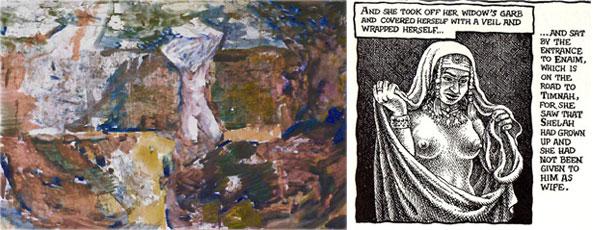
In Aharon April’s painting, Tamar puts off her widow’s clothing (v.14), kneeling, perhaps to presage her intentions with Judah. Although her young body is exposed, her face is hidden. The body is any woman, but the face is her exclusive identity being sheltered by the artist. Robert Crumb’s approach is a vulgar contrast. In his well-known comics style, he gleefully portrays Tamar as an Amazon: her face and body are exposed, she is a sexy schemer.
Most artwork on our story deals with the meeting of Judah and Tamar. But each one takes a different approach to the event and the text, especially with regard to exposure and concealment. The text reads:
14 So she took off her widow’s garb, covered her face with a veil, and, wrapping (or prettying) herself up, sat down at the entrance to Enaim, which is on the road to Timnah… 15When Judah saw her, he took her for a harlot; for she had covered her face. 16So he turned aside to her by the road and said, “Here, let me lie with you”—for he did not know that she was his daughter-in-law.
Our artists play fast and loose with this text.
In the Alba Bible, Tamar is a totally covered and unrecognizable female form.
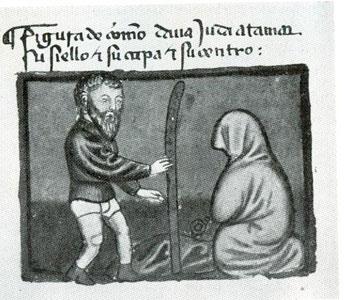
In fact, it is Judah who is exposed, standing in his underwear, and offering Tamar the three security objects. His staff is blatantly phallic, his seal is a ring lying on the ground in front of Tamar. The problematic object is the פתיל, which has been interpreted in many different ways by commentators:
The Vulgate (Latin) armilla = bracelet or necklace
Onkelos (Aramaic)שושיפא= cloak
Targum Pseudo-Jonathan (Aramaic) חוטא = thread, cord
Escorial Bible (Spanish, 14th-15th century) alhareme = fillet, turban or
cloak; suario = napkin
Ferrara Bible (Ladino, 1553) manto = coat
According to the Alba Bible, the petil is a cloak, translated as capa in the Spanish text. We will return later to this object and its significance for the story.
In Chagall’s treatment of this scene, Tamar’s face is veiled and her body is a tightly clothed manikin on display; the stick-like Judah will have to struggle to penetrate her defenses.
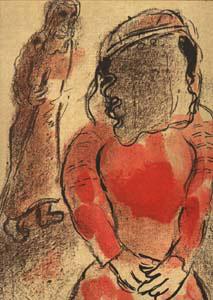
How and where does the uncovering begin?
The "coupling" scene was a favorite of 17th century Dutch artists and those influenced by them.
Willem Drost, a student of Rembrandt, is the most sensitively humane. Tamar is entirely and primly clothed but her veil is merely ceremonial, since her face can be seen through it. Judah is gentle and refined; his right arm touches hers tentatively. If an invitation is forthcoming, the process is slow and patient.
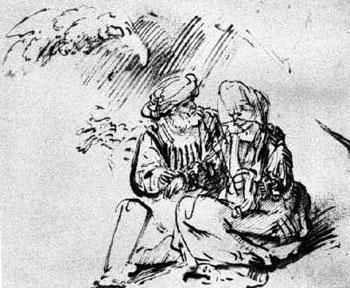
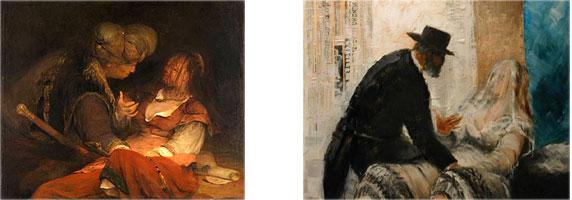
In one of Aert de Gelder’s several renditions of the scene, Tamar’s face is veiled concealing her features, but her bodice is seductively open. There’s an aggressive play; Judah’s staff is at the ready, his right hand grabs her knee, her left hand pushes it away. At the same time, her right hand is negotiating for her services.
Richard McBee, an orthodox Jew, composes his scene following de Gelder’s painting. Tamar’s veil has become longer and Judah’s staff has disappeared. Surprisingly to us, McBee’s Judah is a Hasid. How does this affect the meaning of the painting and its interpretation of the biblical scene?
In much artwork, color creates the emotional content. In contrast, D. Bennet creates emotional content in black and white.
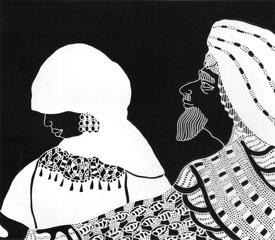
It occurred to us to ask what would happen if we reversed the colors. An entirely different narrative came into being. We saw the opportunity of interpreting the text and the art against the principle of what is revealed and what is hidden. With that principle in mind we can look at Bennett’s painting.
It’s our thinking that Bennett did the black on white version first.
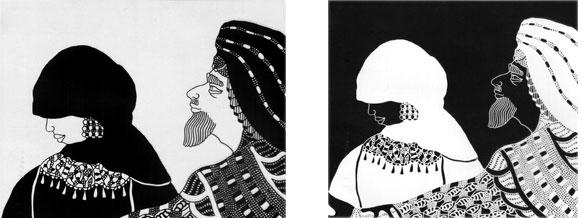
Tamar looks like a Bedouin woman, dressed in black, although, according to the text, she has removed her widow’s garb. Her face is partially covered and turned away from Judah. Her eyes are covered, whereas Judah’s eyes are wide open, viewing her from behin. Tamar is wearing prominent earrings and an ornamental scarf. Judah’s left arm is extended toward her, his clothing festive. This seems like a literal illustration of the scene.
In the inverted (“original”) version, greater mystery prevails. Tamar is dressed in luminous white, the opposite of her widow’s garb. Both faces disappear into the black background. While Judah’s ornate garment is prominent in the foreground, Tamar’s luminous whiteness is the center of our focus. The black background acquires its own mysterious shape. It is a wedge between the two. Bennett’s treatment of the story is a midrashic play on the biblical account; it comments visually on the hiding and revealing, the dressing and undressing of the original story.
Early 18th century artist Gerard Hoet deals with exposure and concealment by differentiating what the viewer sees and what Judah sees.
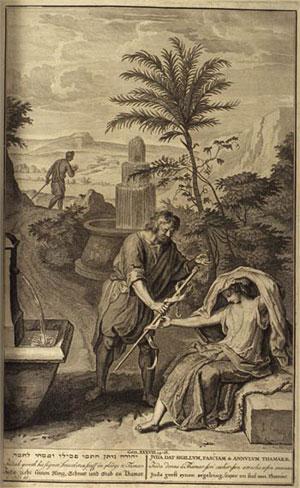
Tamar is half-hidden from Judah under an enveloping canopy. We, the viewers, however, see her, scantily clothed. Her right arm and his right arm merge at the staff, which connects both parts of the scene.
Two voyeuristic treatments
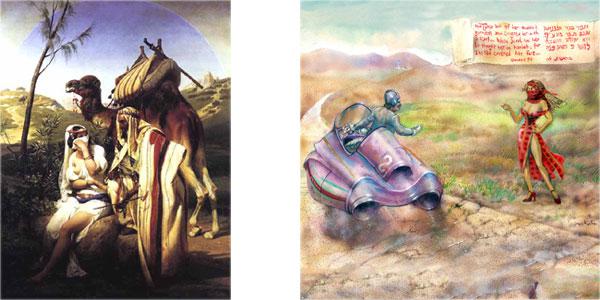
Our path has moved us from concealed to revealed. We arrive at our last two examples, separated by approximately 150 years. Vernet’s Judah and Tamar is typical of orientalist treatments of biblical themes; it is the sub rosa aspect of proper 19th century society, finding an outlet for pent-up sexuality in the “mysterious East”. While the fair Tamar covers her face, her breast and thigh are exposed both to the viewer and to the swarthy Judah himself. A camel is a witness to the transaction and stamps the scene as “Middle Eastern”, as do Judah’s and Tamar’s costumes.
Avi Katz throws the biblical story into science fiction, treating Tamar as an “alien” maiden. Judah, passing by in a spaceship, stops to proposition the provocatively dressed "working girl". Both characters gesticulate to represent their conversation. She is concealed only by her scarf, the archetypal means of going in cognito.
In both of these works, in contrast to most of the earlier treatments of the story, exposure has become more blatant, voyeuristic and crass.
Three contemporary renditions
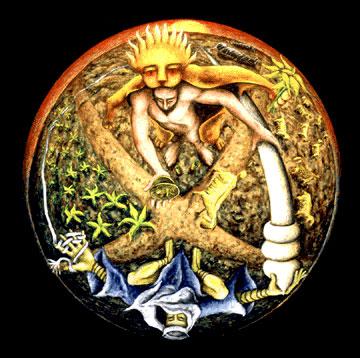
Morris Zagha, Judah and Tamar
The circular format of Morris Zagha’s biblical paintings in the series "Myths and Transformations" is a visual midrash in the most dramatic way, because there’s no single defined angle of view. The disc turns on a hinge, forcing the viewer to constantly see it from a different angle. The two most prominent features in the treatment of Judah and Tamar are the crossroads and the staff. The meeting takes place here, as in a number of targumim and commentaries , at a crossroad, with the two characters facing one another, seemingly far apart. In fact, they are paired opposites; Judah is totally nude, but crowned by a lion’s skin, representing the royal status of the tribe that he will engender. Tamar is almost completely covered, but her squatting position makes her entirely accessible. Both hold out their hands – in each case, one hand offers something (Judah, a bowl with his seed and Tamar, Judah’s identifying thread ) and the other hand grasps the staff, grossly exaggerated and phallic. The sheep on one side and the plants on the other are symbols of fertility. Thus Zagha portrays the meeting as a symbiotic pact, insuring continuity
Archie Rand’s treatment of the story of Judah and Tamar is part of his series “The Nineteen Diaspora Paintings,” referencing the nineteen blessings of the daily prayers. The link of our story to the third blessing, God’s Holy Name (ha’el hakadosh), is certainly enigmatic. In our text, Judah’s companion, looking for Judah’s prostitute (zonah), refers to her as a kedesha. We suggest that Rand is making an ironic play, transforming kadosh in the prayer into kedesha, its opposite.
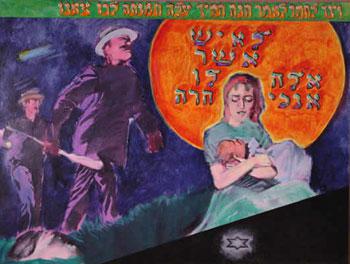
Archie Rand, Judah and Tamar
As in the other paintings of the series, two quotations from the biblical text are integrated into Rand’s pulp fiction-like transmutations:
And Tamar was told, “Your father-in-law is going up to Timnah
to shear his sheep”. (v. 13)
The man who owns these things got me pregnant. (v. 25)
These verses frame the action around the denouement of the story – Rand has interpreted them literally, while at the same time decontextualizing them from their original settings. Here, Judah appears climbing a hill, armed with a club, followed by a companion holding a flashlight. He looks angry, like an enraged father of the bride hunting in the middle of the night for her seducer. Tamar sits with a baby in her arms; above her the large angry moon adds to the nocturnal atmosphere. Below Tamar is a magen david – transporting us to the nighttime of the Shoah. The biblical story of a woman overcoming her fate becomes a melodrama of a woman concealing her secret lover. In this way, Rand conceals the biblical story and reveals his own personal associations with it.
Dian Blair Goodpasture’s stained glass summarizes the entire story. She hides Tamar’s eyes, but places an eye on her bracelet. These are visual puns on the location of the biblical tryst, “פתח עיניים” (lit., “eye opener”)
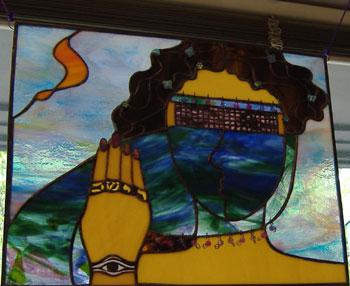
The mark in the upper left seems to be a yod, God’s signature. It leads the eye down to the Hebrew word וישב (the Torah portion in which our story is found) and then to her bracelet. The thumb of her right hand is hidden – she’s holding something back/concealing her “cards”. It’s a kind of hinting at God’s plan being revealed here. A beautiful face and lovely hair, a mesh covers her eyes and a veil her mouth.
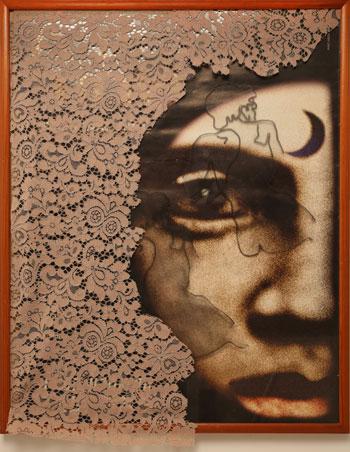
Jo Milgrom
Tamar and Yehudah (Genesis 38)
Unwilling to wait for an arranged marriage
to a youth not yet mature
Tamar plots to seduce his father
wholly indifferent to her needs
The figures within her strong face
(collaged transparencies)
convey her emotional state
and hint of her bold plan
a lace curtain and black moon
embody
the nocturnal encounter
the critical coverup
the eventual disclosure
and the final vindication
Judah’s emotional life
By far, the most interesting work that we have uncovered concerning Judah and Tamar is that of Kevin Rolly, who penetrates the emotional life of Judah. This is in contrast to all of the other work, where Tamar is the center of interest.
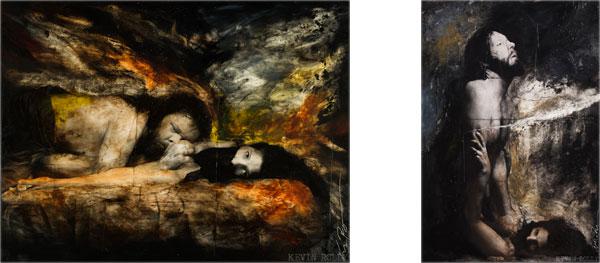
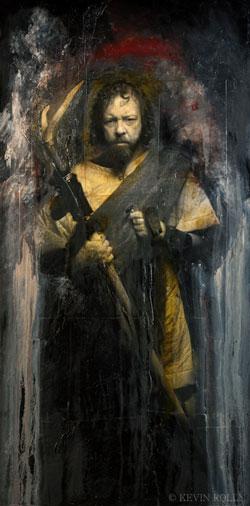
The titles of Rolly’s works are an additional means of commenting on the story. “Loss and deception”, the title of Judah’s intercourse with Tamar, can refer to his story or hers. “The grief of Judah” focuses attention on him; she is marginally present in the picture. In the third painting, “The penitent heart” Judah is humbled as he recognizes Tamar’s justified act.
In all three of Rolly’s portrayals of the story, Judah is the central character. Not only that, but Rolly has great empathy for Judah, showing him buffeted by circumstances and not knowing what to do with his life. Judah is engulfed in loss, needing solace. Tamar is hardly seen, supine, her mouth covered, her voice silenced. Perhaps Rolly is saying that Judah does not recognize Tamar because he is inwardly focused only on his losses. Tamar, according to Rolly, has a burning need to be a mother, so she becomes a vessel to carry the sons to be born to them.
Rolly the artist is also a theologian. He writes in connection with his oilgraphs:
Not until the story completes itself in the centuries to come did all of it become clear. For if one believes in such things, there was a lineage spelled out in a bloodline that began with a man named Abraham and ended with a foretold Messiah. Whether Jesus was the Messiah is not for this story to argue, but his history reached backwards through a litany of names unknown to most - Jacob, Akim, Manasseh, David, Perez....and a woman who just wanted a baby.
The story’s significance
Rolly’s theological musings, prefiguring the coming of a Messiah, bring us back to the curious trio of objects given as pledge to Tamar by Judah. Bereshit Rabba, for example, provides a discussion of the symbolism of the pledge objects.
Thus the Midrash understands all three of the pledge objects as alluding to aspects of the future Messianic leadership of Israel, which will derive from Judah. The seal is the Davidic kingship, the cord is Rabbinic authority and the staff is the Messiah himself.
As mentioned above, the Alba Bible gives a similar interpretation:
La capa significa los dotores con sus capas e honestas rropas e
estos son losque llaman entre judio los sanhedrin
The cape [petil] signifies the rabbis with their capes and solemn
robes and these are called by the Jews “the Sanhedrin”.
In both cases, the sexual character of the story is deemed insufficient. Concealed behind the sexy story is the story of redemption.
Early on, we asked what this story is doing within the Joseph narrative? The rabbinic understanding of the pledge objects stresses the nation’s divinely sanctioned leadership. When the sale of Joseph into slavery threatens this leadership, Judah becomes the focus. Despite Judah’s less than regal behavior in our story, he becomes the ancestor of King David and the Messiah. The personal fates of Judah and Joseph are intertwined in the divine plan for Israel.
For additional images on this subject see TALI Visual Midrash
A Handmade Midrash Workshop
Materials: paper, cloth and wood (toothpicks)
Using these items, show/visualize/extract the relationship of Judah and Tamar in three scenes:
Vv 1 – 11, 12 – 23, 24 – 30
How has the exercise influenced your view of their relationships?



